List of Poaceae genera
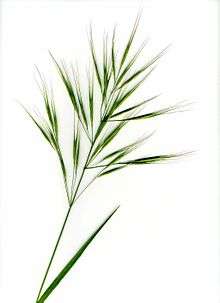
The true grasses (Poaceae) are one of the largest plant families, with around 12,000 species and roughly 800 genera.[1] They contain, among others, the cereal crop species and other plants of economic importance, such as the bamboos, and several important weeds.
Grasses probably originated in the understory of tropical rainforests in the Late Cretaceous, but have since come to occupy a wide range of different habitats.[2][3] Notably, they are the dominant species in grasslands, open habitats that cover around one fifth of the earth's terrestrial surface.[2] The C4 photosynthetic pathway has evolved at least 22 times independently in the grasses; C4 species are more competitive than C3 plants in open habitats with high light intensity and warm temperatures.[4]
The deeper relationships in the family have been resolved by recent molecular phylogenetic work.[4] This has been translated into a modern classification which divides the grasses into twelve subfamilies and a number of tribes, with large tribes further divided into subtribes.[1]
Anomochlooideae, Pharoideae and Puelioideae are early diverging lineages containing only a few species. Most of the diversity falls into the two big BOP and PACMAD clades, which each contain roughly halve of the family's species. C4 lineages have only evolved in the PACMAD clade, whereas many lineages in the BOP clade have evolved adaptations to cold climate.
While the higher-level classification of the grasses is now relatively well understood, taxonomic efforts continue at the species and genera level, and with continuing phylogenetic research, a number of names is likely to change.[5] The list of genera below is therefore likely to evolve with further study.
Genera
.jpg)
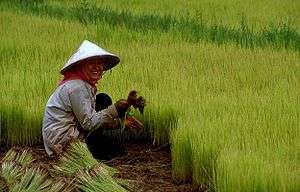
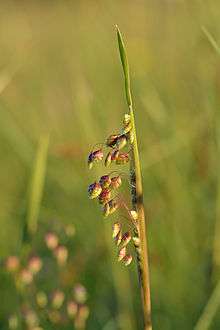
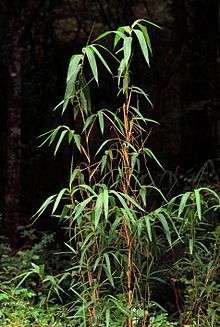
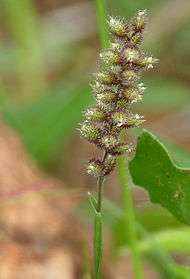
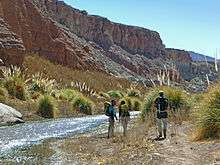
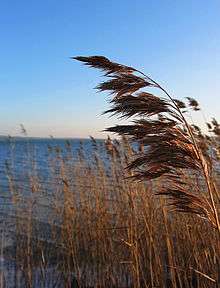
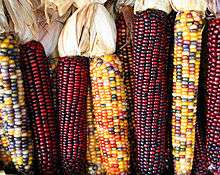
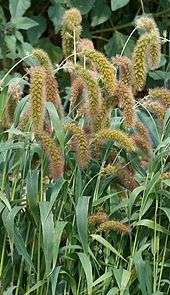
- Acamptoclados
- Achlaena
- Achnatherum
- Aciachne
- Acidosasa
- Acostia
- Acrachne
- Acritochaete
- Acroceras
- Actinocladum
- Aegilops
- Aegopogon
- Aeluropus
- Afrotrichloris
- Agenium
- Agnesia
- Agropyron
- Agropyropsis
- Agrostis
- Aira
- Airopsis
- Alexfloydia
- Alloeochaete
- Allolepis
- Alloteropsis
- Alopecurus
- Alvimia
- Amblyopyrum
- Ammochloa
- Ammophila
- Ampelodesmos
- Amphibromus
- Amphicarpum
- Amphipogon
- Anadelphia
- Ancistrachne
- Ancistragrostis
- Andropogon
- Andropterum
- Anemanthele
- Aniselytron
- Anisopogon
- Anomochloa
- Anthaenantiopsis
- Anthaenantia
- Anthephora
- Anthochloa
- Anthoxanthum
- Antinoria
- Apera
- Aphanelytrum
- Apluda
- Apochiton
- Apoclada
- Apocopis
- Arberella
- Arctagrostis
- Arctophila
- Aristida
- Arrhenatherum
- Arthragrostis
- Arthraxon
- Arthropogon
- Arthrostylidium
- Arundinaria
- Arundinella
- Arundo
- Arundoclaytonia
- Asthenochloa
- Astrebla
- Athroostachys
- Atractantha
- Aulonemia
- Australopyrum
- Austrochloris
- Austrodanthonia
- Austrofestuca
- Austrostipa
- Avellinia
- Avena
- Axonopus
- Bambusa
- Baptorhachis
- Bealia
- Beckeropsis
- Beckmannia
- Bellardiochloa
- Bewsia
- Bhidea
- Blepharidachne
- Blepharoneuron
- Boissiera
- Boivinella
- Borinda
- Bothriochloa
- Bouteloua
- Brachiaria
- Brachyachne
- Brachychloa
- Brachyelytrum
- Brachypodium
- Briza
- Bromuniola
- Bromus
- Brylkinia
- Buchloe
- Buchlomimus
- Buergersiochloa
- Calamagrostis
- Calamovilfa
- Calderonella
- Calosteca
- Calyptochloa
- Camusiella
- Capillipedium
- Castellia
- Catabrosa
- Catabrosella
- Catalepis
- Catapodium
- Cathestecum
- Cenchrus
- Centotheca
- Centrochloa
- Centropodia
- Cephalostachyum
- Chaboissaea
- Chaetium
- Chaetobromus
- Chaetopoa
- Chaetopogon
- Chaetostichium
- Chamaeraphis
- Chandrasekharania
- Chasechloa
- Chasmanthium
- Chasmopodium
- Chevalierella
- Chikusichloa
- Chimonobambusa
- Chionachne
- Chionochloa
- Chloachne
- Chloris
- Chlorocalymma
- Chrysochloa
- Chrysopogon
- Chumsriella
- Chusquea
- Cinna
- Cladoraphis
- Clausospicula
- Cleistachne
- Cleistochloa
- Cliffordiochloa
- Cockaynea
- Coelachne
- Coelachyropsis
- Coelachyrum
- Coelorachis
- Coix
- Colanthelia
- Coleanthus
- Colpodium
- Commelinidium
- Cornucopiae
- Cortaderia
- Corynephorus
- Cottea
- Craspedorhachis
- Crinipes
- Crithopsis
- Crypsis
- Cryptochloa
- Ctenium
- Ctenopsis
- Cutandia
- Cyathopus
- Cyclostachya
- Cymbopogon
- Cymbosetaria
- Cynodon
- Cynosurus
- Cyperochloa
- Cyphochlaena
- Cypholepis
- Cyrtococcum
- Dactylis
- Dactyloctenium
- Daknopholis
- Dallwatsonia
- Danthonia
- Danthoniastrum
- Danthonidium
- Danthoniopsis
- Dasyochloa
- Dasypoa
- Dasypyrum
- Davidsea
- Decaryella
- Decaryochloa
- Dendrocalamus
- Dendrochloa
- Deschampsia
- Desmazeria
- Desmostachya
- Deyeuxia
- Diandrochloa
- Diandrolyra
- Diandrostachya
- Diarrhena
- Dichaetaria
- Dichanthelium
- Dichanthium
- Dichelachne
- Diectomis
- Dielsiochloa
- Digastrium
- Digitaria
- Digitariopsis
- Dignathia
- Diheteropogon
- Dilophotriche
- Dimeria
- Dimorphochloa
- Dinebra
- Dinochloa
- Diplachne
- Diplopogon
- Dissanthelium
- Dissochondrus
- Distichlis
- Drake-Brockmania
- Dregeochloa
- Drepanostachyum
- Dryopoa
- Dupontia
- Duthiea
- Dybowskia
- Eccoilopus
- Eccoptocarpha
- Echinaria
- Echinochloa
- Echinolaena
- Echinopogon
- Ectrosia
- Ectrosiopsis
- Ehrharta
- Ekmanochloa
- Eleusine
- Elionurus
- Elymandra
- Elymus
- Elytrigia
- Elytrophorus
- Elytrostachys
- Enneapogon
- Enteropogon
- Entolasia
- Entoplocamia
- Eragrostiella
- Eragrostis
- Eremium
- Eremochloa
- Eremopoa
- Eremopogon
- Eremopyrum
- Eriachne
- Erianthecium
- Erianthus
- Eriochloa
- Eriochrysis
- Erioneuron
- Euclasta
- Eulalia
- Eulaliopsis
- Eustachys
- Euthryptochloa
- Exotheca
- Fargesia*Acamptoclados
- Achlaena
- Achnatherum
- Aciachne
- Acidosasa
- Acostia
- Acrachne
- Farrago
- Fasciculochloa
- Festuca
- Festucella
- Festucopsis
- Filgueirasia
- Fingerhuthia
- Froesiochloa
- Garnotia
- Gastridium
- Gaudinia
- Gaudiniopsis
- Germainia
- Gerritea
- Gigantochloa
- Gilgiochloa
- Glaziophyton
- Glyceria
- Glyphochloa
- Gouinia
- Gouldochloa
- Graphephorum
- Greslania
- Griffithsochloa
- Guaduella
- Gymnachne
- Gymnopogon
- Gynerium
- Habrochloa
- Hackelochloa
- Hainardia
- Hakonechloa
- Halopyrum
- Harpachne
- Harpochloa
- Helictotrichon
- Helleria
- Hemarthria
- Hemisorghum
- Henrardia
- Hesperostipa
- Heterachne
- Heteranthelium
- Heteranthoecia
- Heterocarpha
- Heteropholis
- Heteropogon
- Hibanobambusa
- Hickelia
- Hierochloe
- Hilaria
- Hitchcockella
- Holcolemma
- Holcus
- Homolepis
- Homopholis
- Homozeugos
- Hookerochloa
- Hordelymus
- Hordeum
- Hubbardia
- Hubbardochloa
- Humbertochloa
- Hyalopoa
- Hydrochloa
- Hydrothauma
- Hygrochloa
- Hygroryza
- Hylebates
- Hymenachne
- Hyparrhenia
- Hyperthelia
- Hypogynium
- Hypseochloa
- Hystrix
- Ichnanthus
- Imperata
- Indocalamus
- Indopoa
- Indosasa
- Isachne
- Isalus
- Ischaemum
- Ischnochloa
- Ischnurus
- Iseilema
- Ixophorus
- Jansenella
- Jardinea
- Jouvea
- Joycea
- Kampochloa
- Kaokochloa
- Karroochloa
- Kengia
- Kengyilia
- Kerriochloa
- Koeleria
- Lagurus
- Lamarckia
- Lamprothyrsus
- Lasiacis
- Lasiorhachis
- Lasiurus
- Lecomtella
- Leersia
- Lepargochloa
- Leptagrostis
- Leptaspis
- Leptocarydion
- Leptochloa
- Leptochloris
- Leptocoryphium
- Leptoloma
- Leptosaccharum
- Leptothrium
- Lepturella
- Lepturidium
- Lepturopetium
- Lepturus
- Leucophrys
- Leucopoa
- Leymus
- Libyella
- Limnas
- Limnodea
- Limnopoa
- Lindbergella
- Linkagrostis
- Lintonia
- Lithachne
- Littledalea
- Loliolum
- Lolium
- Lombardochloa
- Lophacme
- Lophatherum
- Lopholepis
- Lophopogon
- Lophopyrum
- Lorenzochloa
- Loudetia
- Loudetiopsis
- Louisiella
- Loxodera
- Luziola
- Lycochloa
- Lycurus
- Lygeum
- Maclurolyra
- Maillea
- Malacurus
- Maltebrunia
- Manisuris
- Megalachne
- Megaloprotachne
- Megastachya
- Melanocenchris
- Melica
- Melinis
- Melocalamus
- Melocanna
- Merostachys
- Merxmuellera
- Mesosetum
- Metasasa
- Metcalfia
- Mibora
- Micraira
- Microbriza
- Microcalamus
- Microchloa
- Microlaena
- Micropyropsis
- Micropyrum
- Microstegium
- Mildbraediochloa
- Milium
- Miscanthidium
- Miscanthus
- Mnesithea
- Mniochloa
- Molinia
- Monachather
- Monanthochloe
- Monelytrum
- Monium
- Monocladus
- Monocymbium
- Monodia
- Mosdenia
- Muhlenbergia
- Munroa
- Myriocladus
- Myriostachya
- Narduroides
- Nardus
- Narenga
- Nassella
- Nastus
- Neeragrostis
- Neesiochloa
- Nematopoa
- Neobouteloua
- Neohouzeaua
- Neostapfia
- Neostapfiella
- Nephelochloa
- Neurachne
- Neurolepis
- Neyraudia
- Notochloe
- Notodanthonia
- Ochlandra
- Ochthochloa
- Odontelytrum
- Odyssea
- Olmeca
- Olyra
- Ophiochloa
- Ophiuros
- Opizia
- Oplismenopsis
- Oplismenus
- Orcuttia
- Oreobambos
- Oreochloa
- Orinus
- Oropetium
- Ortachne
- Orthoclada
- Oryza
- Oryzidium
- Oryzopsis
- Otachyrium
- Otatea
- Ottochloa
- Oxychloris
- Oxyrhachis
- Oxytenanthera
- Panicum
- Pappophorum
- Parafestuca
- Parahyparrhenia
- Paraneurachne
- Parapholis
- Paratheria
- Parectenium
- Pariana
- Parodiolyra
- Pascopyrum
- Paspalidium
- Paspalum
- Pennisetum
- Pentameris
- Pentapogon
- Pentarrhaphis
- Pentaschistis
- Pereilema
- Periballia
- Peridictyon
- Perotis
- Perrierbambus
- Perulifera
- Peyritschia
- Phacelurus
- Phaenanthoecium
- Phaenosperma
- Phalaris
- Pharus
- Pheidochloa
- Phippsia
- Phleum
- Pholiurus
- Phragmites
- Phyllorachis
- Phyllostachys
- Pilgerochloa
- Piptatherum
- Piptochaetium
- Piptophyllum
- Piresia
- Piresiella
- Plagiantha
- Plagiosetum
- Planichloa
- Plectrachne
- Pleiadelphia
- Pleioblastus
- Pleuropogon
- Plinthanthesis
- Poa
- Pobeguinea
- Podophorus
- Poecilostachys
- Pogonachne
- Pogonarthria
- Pogonatherum
- Pogoneura
- Pogonochloa
- Pohlidium
- Poidium
- Polevansia
- Polliniopsis
- Polypogon
- Polytoca
- Polytrias
- Pommereulla
- Porteresia
- Potamophila
- Pringleochloa
- Prionanthium
- Prosphytochloa
- Psammagrostis
- Psammochloa
- Psathyrostachys
- Pseudanthistiria
- Pseudarrhenatherum
- Pseudechinolaena
- Pseudobromus
- Pseudochaetochloa
- Pseudocoix
- Pseudodanthonia
- Pseudodichanthium
- Pseudopentameris
- Pseudophleum
- Pseudopogonatherum
- Pseudoraphis
- Pseudoroegneria
- Pseudosasa
- Pseudosorghum
- Pseudostachyum
- Pseudovossia
- Pseudoxytenanthera
- Pseudozoysia
- Psilathera
- Psilolemma
- Psilurus
- Pterochloris
- Ptilagrostis
- Puccinellia
- Puelia
- Racemobambos
- Raddia
- Raddiella
- Ratzeburgia
- Redfieldia
- Reederochloa
- Rehia
- Reimarochloa
- Reitzia
- Relchela
- Rendlia
- Reynaudia
- Rhipidocladum
- Rhizocephalus
- Rhomboelytrum
- Rhynchelytrum
- Rhynchoryza
- Rhytachne
- Richardsiella
- Robynsiochloa
- Rottboellia
- Rytidosperma
- Saccharum
- Sacciolepis
- Sartidia
- Sasa
- Sasaella
- Sasamorpha
- Saugetia
- Schaffnerella
- Schedonnardus
- Schenckochloa
- Schismus
- Schizachne
- Schizachyrium
- Schizostachyum
- Schmidtia
- Schoenefeldia
- Sclerachne
- Sclerochloa
- Sclerodactylon
- Scleropogon
- Sclerostachya
- Scolochloa
- Scribneria
- Scrotochloa
- Scutachne
- Secale
- Sehima
- Semiarundinaria
- Sesleria
- Sesleriella
- Setaria
- Setariopsis
- Shibataea
- Silentvalleya
- Simplicia
- Sinarundinaria
- Sinobambusa
- Sinochasea
- Sitanion
- Snowdenia
- Soderstromia
- Sohnsia
- Sorghastrum
- Sorghum
- Spartina
- Spartochloa
- Spathia
- Sphaerobambos
- Sphaerocaryum
- Spheneria
- Sphenopholis
- Sphenopus
- Spinifex
- Spodiopogon
- Sporobolus
- Steinchisma
- Steirachne
- Stenotaphrum
- Stephanachne
- Stereochlaena
- Steyermarkochloa
- Stiburus
- Stilpnophleum
- Stipa
- Stipagrostis
- Streblochaete
- Streptochaeta
- Streptogyna
- Streptolophus
- Streptostachys
- Styppeiochloa
- Sucrea
- Suddia
- Swallenia
- Swallenochloa
- Symplectrodia
- Taeniatherum
- Taeniorhachis
- Tarigidia
- Tatianyx
- Teinostachyum
- Tetrachaete
- Tetrachne
- Tetrapogon
- Tetrarrhena
- Thamnocalamus
- Thaumastochloa
- Thelepogon
- Thellungia
- Themeda
- Thinopyrum
- Thrasya
- Thrasyopsis
- Thuarea
- Thyridachne
- Thyridolepis
- Thyrsia
- Thyrsostachys
- Thysanolaena
- Torreyochloa
- Tovarochloa
- Trachypogon
- Trachys
- Tragus
- Tribolium
- Tricholaena
- Trichoneura
- Trichopteryx
- Tridens
- Trikeraia
- Trilobachne
- Triniochloa
- Triodia
- Triplachne
- Triplasis
- Triplopogon
- Tripogon
- Tripsacum
- Triraphis
- Triscenia
- Trisetum
- Tristachya
- Triticum
- Tuctoria
- Uniola
- Uranthoecium
- Urelytrum
- Urochloa
- Urochondra
- Vahlodea
- Vaseyochloa
- Ventenata
- Vetiveria
- Vietnamochloa
- Vietnamosasa
- Viguierella
- Vossia
- Vulpia
- Vulpiella
- Whiteochloa
- Willkommia
- Xerochloa
- Yakirra
- Ystia
- Yushania
- Yvesia
- Zea
- Zenkeria
- Zeugites
- Zingeria
- Zizania
- Zizaniopsis
- Zonotriche
- Zotovia
- Zoysia
- Zygochloa
References
- 1 2 Soreng, Robert J.; Peterson, Paul M.; Romschenko, Konstantin; Davidse, Gerrit; Zuloaga, Fernando O.; Judziewicz, Emmet J.; Filgueiras, Tarciso S.; Davis, Jerrold I.; Morrone, Osvaldo (2015). "A worldwide phylogenetic classification of the Poaceae (Gramineae)". Journal of Systematics and Evolution. 53 (2): 117–137. doi:10.1111/jse.12150. ISSN 1674-4918.

- 1 2 Edwards, E. J.; Smith, S. A. (2010). "Phylogenetic analyses reveal the shady history of C4 grasses". Proceedings of the National Academy of Sciences. 107 (6): 2532–2537. doi:10.1073/pnas.0909672107. ISSN 0027-8424. PMC 2823882
 . PMID 20142480.
. PMID 20142480. 
- ↑ Christin, P.-A.; Spriggs, E.; Osborne, C. P.; Stromberg, C. A. E.; Salamin, N.; Edwards, E. J. (2013). "Molecular Dating, Evolutionary Rates, and the Age of the Grasses". Systematic Biology. 63 (2): 153–165. doi:10.1093/sysbio/syt072. ISSN 1063-5157.

- 1 2 Grass Phylogeny Working Group II (2012). "New grass phylogeny resolves deep evolutionary relationships and discovers C4 origins". New Phytologist. 193 (2): 304–312. doi:10.1111/j.1469-8137.2011.03972.x. ISSN 0028-646X. PMID 22115274.

- ↑ Vorontsova, Maria S.; Simon, Bryan K. (2012). "Updating classifications to reflect monophyly: 10 to 20 percent of species names change in Poaceae" (PDF). Taxon. 61 (4): 735–746.